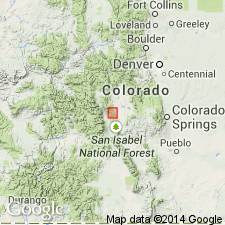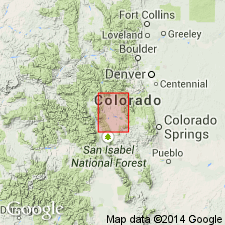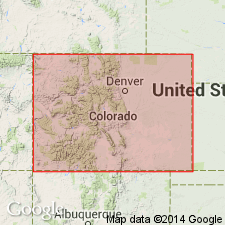
- Usage in publication:
-
- Pony Spring siltstone member
- Modifications:
-
- Named
- Dominant lithology:
-
- Siltstone
- Sandstone
- Shale
- AAPG geologic province:
-
- Eagle basin
- South Park basin
Summary:
Named as upper member of Maroon formation for Pony Spring, west side of Pony Park near sec 28, T12S, R77W, Park Co, CO in South Park basin. Type section measured in secs 20, 29, 32, and 33, T12S and secs 5 and 16, T13S, R77W, Park Co, where member is 5,931 ft thick. Conformably overlies Chubb siltstone member (new) of Maroon. Upper contact concealed. Upper limit in area is a Tertiary erosion surface produced before extrusion of Buffalo Peaks andesite (new). Is older than an unnamed part of Maroon regionally. Shown on geologic map in Park and Chaffee (Eagle basin) Cos, with basal Bath submember (new) forming the western outcrop limit [submember is not an accepted formal rank]. Composed at type of: red-gray, gray-green to chocolate-brown, generally micaceous, occasionally ripple-marked, calcareous, cross- to even-laminated siltstone; green-gray, arkosic, sparsely micaceous, massive to thinly laminated to ripple-marked sandstone; gray, calcareous, micaceous shale that has carbonaceous layers. Forms valleys (shale, siltstone) and ridges (sandstone). Permian age. Fossil plants.
["Submember" not recognized as a formal stratigraphic rank term (CSN, 1933; ACSN, 1961, 1970; NACSN, 1983, 2005). Considered informal until formally published. The rank or lithologic term should not be capitalized.]
Source: GNU records (USGS DDS-6; Denver GNULEX).

- Usage in publication:
-
- Pony Spring siltstone member
- Modifications:
-
- Overview
- AAPG geologic province:
-
- South Park basin
- Eagle basin
Summary:
Is a member of Maroon formation of Permian age. Mapped in southwest part of area (geologic map), Ts11, 12, and 13S, Rs77 and 78W, Chaffee Co, CO in the Eagle basin and adjoining Park Co, CO in the South Park basin. Conformably above Chubb member of Maroon formation. Is nearly 6,000 ft thick. Includes Bath sandstone [an unranked unit]--called submember by Gould--at base. Upper limit is a Tertiary erosion surface now concealed by lavas and talus. Correlation diagram. [Repeats information of Gould, 1935.]
["Submember" not recognized as a formal stratigraphic rank term (CSN, 1933; ACSN, 1961, 1970; NACSN, 1983, 2005). Considered informal until formally published. The rank or lithologic term should not be capitalized.]
Source: GNU records (USGS DDS-6; Denver GNULEX).

- Usage in publication:
-
- Pony Spring Member
- Modifications:
-
- Redescribed
- AAPG geologic province:
-
- South Park basin
Summary:
Pg. 216-217, 224+ (measured sections). Pony Spring Member of Maroon Formation. Red, brown, gray, to green, arkosic sandstones, feldspathic siltstones, and gray shales. Color becomes redder and less gray higher in section. Thickness about 5,900 feet. Conformably overlies Chubb Member of Maroon Formation. Upper contact is a Tertiary erosional surface. Fossils. Traces of fossil plants WALCHIA PINIFORMIS, W. GRACILIS, VOLTZIE, and ULMANNIA, pelecypods related to freshwater genus CARBONICOLA, ostracode CARBONITA(?) TUMIDA MAGMA, and vertebrate footprints (citing Gould, 1935; Brill, 1952). Age is probably Des Moinesian to Wolfcampian [Middle Pennsyvlanian to Early Permian], based on stratigraphic relations and fossil assemblages.
Source: Publication.
For more information, please contact Nancy Stamm, Geologic Names Committee Secretary.
Asterisk (*) indicates published by U.S. Geological Survey authors.
"No current usage" (†) implies that a name has been abandoned or has fallen into disuse. Former usage and, if known, replacement name given in parentheses ( ).
Slash (/) indicates name conflicts with nomenclatural guidelines (CSN, 1933; ACSN, 1961, 1970; NACSN, 1983, 2005, 2021). May be explained within brackets ([ ]).

